- Tips for Growing Syrian Hibiscus
- 1. Choose the right location
- 2. Provide proper watering
- 3. Fertilize regularly
- 4. Prune for shape
- 5. Provide support if needed
- 6. Watch out for pests and diseases
- 7. Mulch to conserve moisture
- 8. Protect from frost
- Choosing the Right Location
- Sunlight
- Temperature
- Soil Drainage
- Protection from Wind
- Space
- Providing Proper Sunlight
- Watering and Soil Needs
- Soil Preparation
- Mulching
- Fertilization
- Fertilizing and Pruning
- Popular Varieties of Syrian Hibiscus
- Red Velvet Hibiscus
- Growing Tips
- Varieties
- In Conclusion
- Blushing Bride Hibiscus
- Description
- Growing Tips
- Varieties
- Golden Sunshine Hibiscus
- Growing Tips
- Varieties
- Uses
- Conclusion
- Questions and Answers:
- What are some tips for growing Syrian hibiscus?
- Can Syrian hibiscus tolerate cold temperatures?
- What are some popular varieties of Syrian hibiscus?
- How often should I water Syrian hibiscus?
- Do Syrian hibiscus require a lot of sunlight?
- How can I propagate Syrian hibiscus?
- Videos: How to Grow Hardy Hibiscus
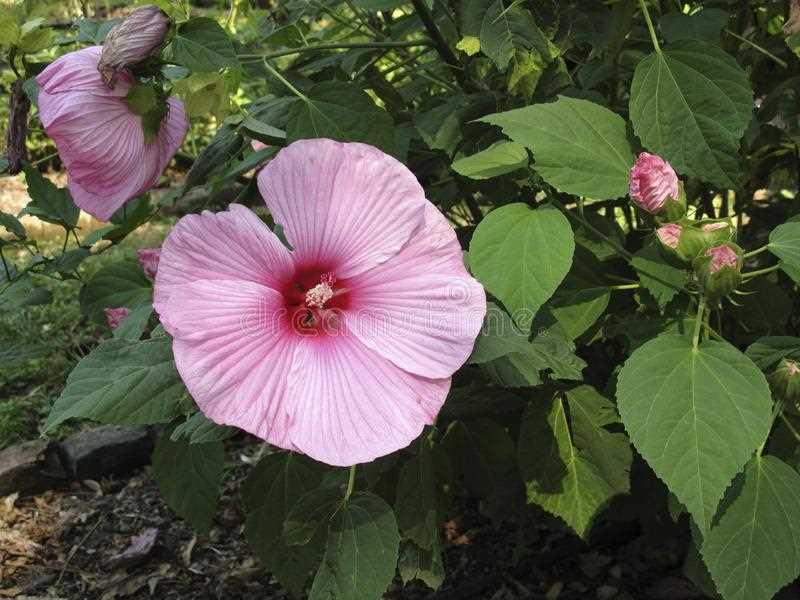
The Syrian hibiscus, known for its vibrant colors and stunning blooms, is a popular choice for many garden enthusiasts. With its origins in the Middle East, this tropical flower has captured the hearts of gardeners around the world. In this article, we will explore some growing tips for the Syrian hibiscus as well as the various varieties available.
One of the key factors in successfully growing Syrian hibiscus is providing the right growing conditions. These flowers thrive in full sun, so it is important to find a spot in your garden that receives at least six hours of direct sunlight each day. Additionally, they prefer well-drained soil, so make sure to choose a location with good drainage.
When it comes to watering, the Syrian hibiscus prefers to be kept consistently moist but not waterlogged. It is best to water deeply once or twice a week rather than giving it frequent shallow waterings. Mulching the soil around the plant can also help retain moisture and regulate soil temperature.
There are a wide variety of Syrian hibiscus available for you to explore and add to your garden. From the classic red and yellow varieties to the exotic purple and white ones, there is a color and style to suit every taste. Some popular varieties include ‘Red Hot’, ‘Snow Queen’, and ‘Midnight Magic’.
Tips for Growing Syrian Hibiscus
Growing Syrian Hibiscus can be a rewarding and enjoyable experience. Here are some tips to help you successfully grow these beautiful plants:
1. Choose the right location
Syrian Hibiscus plants thrive in full sun or partial shade. Make sure to choose a location in your garden that receives at least 6-8 hours of sunlight per day. The soil should be well-draining and rich in organic matter.
2. Provide proper watering
Water Syrian Hibiscus plants regularly, especially during hot, dry periods. The soil should be kept moist, but not waterlogged. It’s best to water deeply to encourage deep root growth.
3. Fertilize regularly
Feed Syrian Hibiscus plants with a balanced fertilizer every 4-6 weeks during the growing season. This will help promote healthy growth and abundant blooming.
4. Prune for shape
Prune Syrian Hibiscus plants to maintain their shape and size. Remove any dead or diseased branches, as well as any crossing or rubbing branches. Pruning can be done in late winter or early spring.
5. Provide support if needed
If your Syrian Hibiscus plants are tall and tend to flop over, provide support with stakes or a trellis. This will help keep the plants upright and prevent them from bending under the weight of the flowers.
6. Watch out for pests and diseases
Keep an eye out for common pests such as aphids, whiteflies, and spider mites. Treat infestations promptly with organic insecticides or insecticidal soap. Also, watch for signs of diseases such as powdery mildew or leaf spot, and take appropriate measures to control them.
7. Mulch to conserve moisture
Apply a layer of organic mulch around the base of Syrian Hibiscus plants to help conserve moisture, suppress weed growth, and regulate soil temperature. Mulching also adds organic matter to the soil as it decomposes.
8. Protect from frost
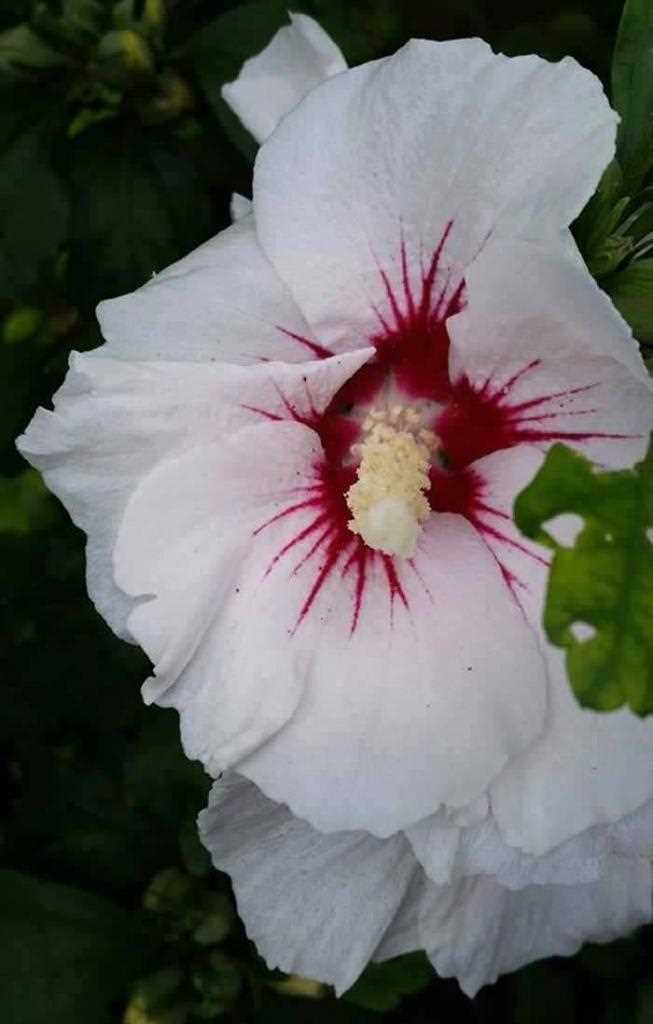

Syrian Hibiscus plants are sensitive to frost. If you live in a frost-prone area, consider growing them in containers so that you can bring them indoors during the winter months. Alternatively, cover the plants with frost cloth or bring them indoors when frost is expected.
By following these tips, you can successfully grow Syrian Hibiscus plants and enjoy their beautiful blooms for years to come.
Choosing the Right Location
When it comes to growing Syrian Hibiscus, choosing the right location is crucial for its optimal growth and blooming. Here are some factors to consider:
Sunlight
Syrian Hibiscus loves sunlight and requires at least 6 to 8 hours of direct sunlight each day. Therefore, it is important to choose a location that receives ample sunlight throughout the day.
Temperature
Syrian Hibiscus thrives in warm temperatures between 60°F (15°C) and 90°F (32°C). It is not tolerant of frost or freezing temperatures, so it is best to plant it in a location where the temperature stays above freezing.
Soil Drainage
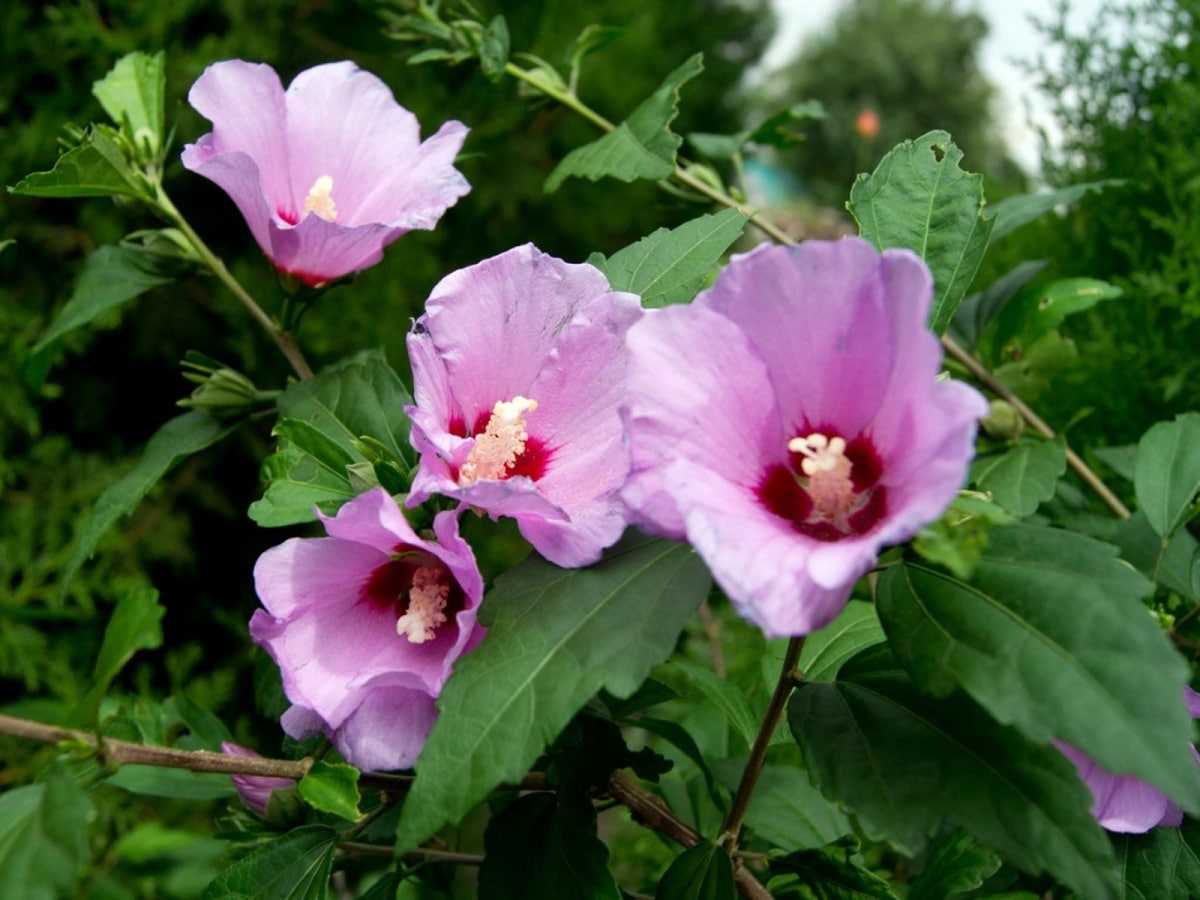

Good soil drainage is essential for the health of Syrian Hibiscus. The roots of the plant should not be in standing water, as it can lead to root rot. Choose a location with well-draining soil to ensure the plant stays healthy.
Protection from Wind
Syrian Hibiscus can be sensitive to strong winds, which can damage its delicate flowers and foliage. Planting it in a location that is protected from strong winds or providing windbreaks can help protect the plant.
Space
Syrian Hibiscus can grow into a large shrub or small tree, so it is important to provide enough space for its growth. Choose a location where the plant has enough room to spread out and reach its full potential.
By considering these factors and choosing the right location for your Syrian Hibiscus, you can ensure its healthy growth and enjoy the beautiful blooms it will produce.
Providing Proper Sunlight
Syrian Hibiscus plants thrive in warm and sunny environments, making it essential to provide them with ample sunlight. Here are some important tips to help you provide the proper sunlight for your Syrian Hibiscus:
- Choose a sunny location: Syrian Hibiscus plants require a minimum of six hours of direct sunlight every day. Select a spot in your garden or patio that receives plenty of sunlight.
- Avoid shade: Avoid placing your Syrian Hibiscus plants in areas with excessive shade as it can hinder their growth and flowering potential.
- Watch for early morning or late afternoon sun: While Syrian Hibiscus plants love sunlight, they may be sensitive to intense midday sun. If your climate has scorching hot summers, it’s best to provide them with morning or late afternoon sun instead of direct midday sun.
- Protect from strong winds: Syrian Hibiscus plants prefer sheltered locations away from strong winds. Select a spot that provides some protection from gusty winds to prevent damage to the leaves and flowers.
By providing your Syrian Hibiscus plants with the proper sunlight, you are setting them up for healthy growth and beautiful blooming throughout the season.
Watering and Soil Needs
Syrian hibiscus plants require a consistent watering schedule to thrive. It is important to keep the soil moist, but not overly saturated. Overwatering can lead to root rot, while underwatering can cause the plant to dry out and die.
When watering your Syrian hibiscus, make sure to water deeply, allowing the water to penetrate the root zone. This encourages the roots to grow deeper and promotes overall plant health. It is recommended to water the plant at least once a week, adjusting the frequency depending on the moisture level of the soil.
The soil should be well-draining to prevent waterlogging. Syrian hibiscus plants prefer slightly acidic to neutral soil with a pH range between 6.0 and 7.0. If your soil is too alkaline, you can add organic matter such as compost or peat moss to lower the pH level.
Soil Preparation
Before planting your Syrian hibiscus, it is essential to prepare the soil properly. Start by removing any weeds or grass from the planting area. Loosen the soil using a garden fork or tiller to a depth of at least 12 inches. This will improve drainage and allow the roots to penetrate the soil more easily.
You can also amend the soil with organic matter such as compost or well-rotted manure. This helps improve the soil fertility and structure, providing essential nutrients to the plants.
Mulching
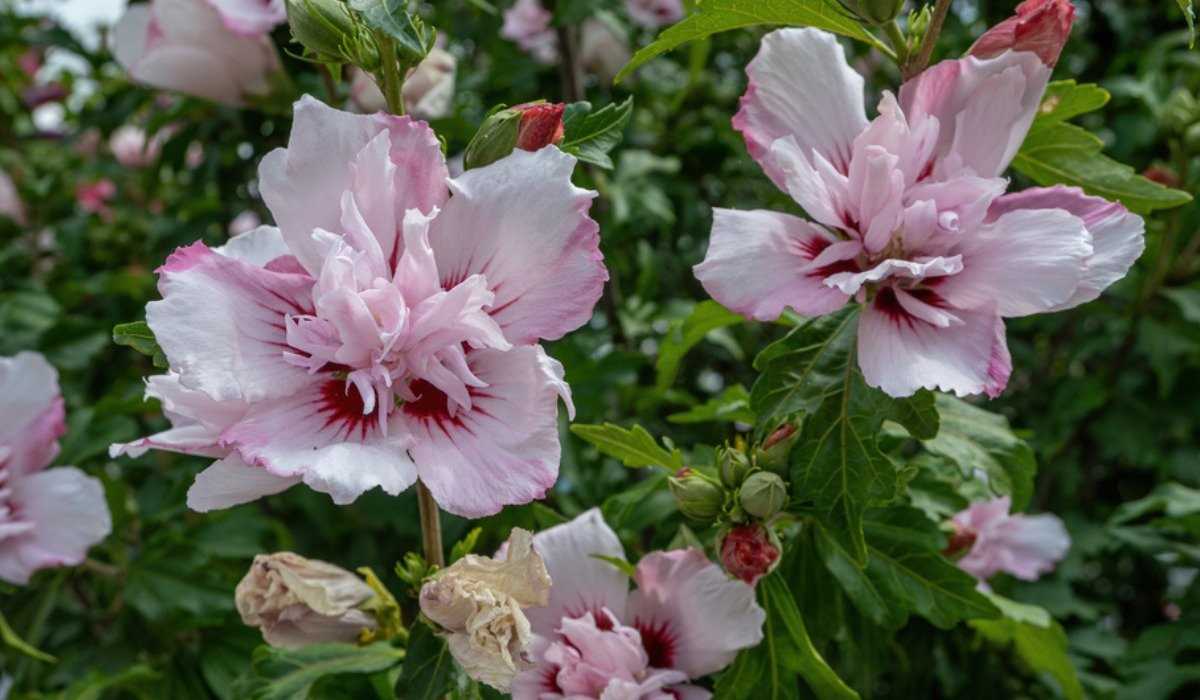

Applying a layer of mulch around the base of the Syrian hibiscus plant can help conserve moisture, suppress weeds, and regulate soil temperature. Organic mulches like wood chips, straw, or leaf litter work well for hibiscus plants.
Spread the mulch evenly around the plant, keeping a distance of a few inches from the stem. This prevents the mulch from directly contacting the plant, which can lead to rotting and disease.
It is important to replenish the mulch layer regularly as it decomposes over time. This will ensure that the benefits of mulching are maintained throughout the growing season.
Fertilization
Syrian hibiscus plants benefit from regular fertilization to maintain healthy growth and abundant blooms. Fertilize the plants with a balanced slow-release granular fertilizer at the beginning of the growing season. Follow the package instructions for the appropriate dosage.
Avoid over-fertilization, as it can result in excessive foliage growth at the expense of flower production. If you notice yellowing leaves or poor flowering, you can apply a water-soluble fertilizer every 4-6 weeks during the growing season.
| Watering | Soil | Mulching | Fertilization |
|---|---|---|---|
| Consistent watering, keeping soil moist but not saturated | Well-draining, slightly acidic to neutral soil (pH 6.0-7.0) | Apply organic mulch to conserve moisture and suppress weeds | Use a balanced slow-release granular fertilizer at the beginning of the season, followed by water-soluble fertilizers every 4-6 weeks |
Fertilizing and Pruning
Fertilizing:
Proper fertilization is essential for the healthy growth of Syrian Hibiscus plants. Apply a balanced slow-release fertilizer in the spring, following the package instructions for application rates. This will provide the necessary nutrients to support vigorous growth and blooming throughout the season. Additionally, supplement with a liquid fertilizer every two to three weeks during the growing season to promote continuous flower production.
Pruning:
Regular pruning helps to keep Syrian Hibiscus plants compact and encourages the development of more blooms. Pruning should be done in the early spring before the new growth begins. Start by removing any dead or damaged branches. Then, selectively prune back the remaining branches to maintain the desired shape and size of the plant. Aim to remove about one-third of the plant’s overall growth, focusing on shaping the plant rather than using excessive pruning.
Cutting Back:
Syrian Hibiscus plants may benefit from a more severe pruning in late winter or early spring every few years. This technique, known as cutting back, involves removing the plant to a height of about 12 inches from the ground. This rejuvenates the plant and encourages new growth from the base. Cutting back can help manage the size of overgrown plants and stimulate increased flowering.
Deadheading:
To encourage continuous blooming, deadhead spent flowers regularly. Simply remove the faded flowers by cutting them back to the nearest healthy bud or leaf node. This will redirect the plant’s energy towards producing new flower buds, resulting in a longer blooming period.
Division:
Syrian Hibiscus plants can be divided and propagated every two to three years to maintain their overall health and vigor. To divide the plant, carefully separate the rootball into two or more sections, ensuring that each section has a good amount of roots and shoots. Replant the divided sections in separate containers or garden beds, providing them with proper care and attention to establish new plants.
Table 1: Recommended Pruning and Fertilizing Schedule
| Month | Activity |
|---|---|
| March | Prune back to shape and remove dead branches |
| April | Apply slow-release balanced fertilizer |
| May – September | Apply liquid fertilizer every 2-3 weeks |
| Throughout the season | Deadhead spent flowers regularly |
| Every 2-3 years | Divide and propagate |
Popular Varieties of Syrian Hibiscus
Syrian hibiscus, also known as Hibiscus rosa-sinensis, is a popular flowering plant that is native to Syria. It is known for its large, showy flowers that come in a variety of colors. There are several popular varieties of Syrian hibiscus that are worth exploring for your garden or landscape. Here are a few of them:
- Black Dragon: This variety is known for its deep crimson flowers with darker red centers. The flowers of the Black Dragon have a unique appearance that adds a touch of drama and elegance to any garden.
- Asian Moon: The Asian Moon variety has large, white flowers with a hint of pink at the base. This variety is known for its ability to attract butterflies and hummingbirds, making it a great choice for those who enjoy wildlife in their garden.
- Fireball: The Fireball variety is known for its vibrant orange-red flowers that are sure to grab attention. This variety is a prolific bloomer and can add a pop of color to any garden or landscape.
- Yellow Emperor: For those who prefer more subtle colors, the Yellow Emperor variety is a great choice. It features beautiful yellow flowers that are sure to brighten up any garden.
If you’re looking to add some color and beauty to your garden, consider planting one of these popular varieties of Syrian hibiscus. With their stunning flowers and easy care, they are sure to be a standout in any landscape.
| Variety | Flower Color | Attracts Wildlife | Bloom Time |
|---|---|---|---|
| Black Dragon | Deep crimson | No | Spring to fall |
| Asian Moon | White with pink | Yes (Butterflies, hummingbirds) | Summer to fall |
| Fireball | Orange-red | No | Summer to fall |
| Yellow Emperor | Yellow | No | Spring to fall |
Red Velvet Hibiscus
The Red Velvet hibiscus is a stunning variety of Syrian hibiscus that features deep, rich red flowers. It is a popular choice among gardeners for its vibrant color and eye-catching beauty.
This variety is known for its large, saucer-shaped flowers that can reach up to 6 inches in diameter. The petals are velvety and have a smooth, luxurious texture that gives the flower its name.
Growing Tips
- Plant the Red Velvet hibiscus in well-draining soil that is rich in organic matter. The plant prefers full sun but can tolerate some shade.
- Water the hibiscus regularly, keeping the soil moist but not waterlogged. Avoid overwatering as it can lead to root rot.
- Feed the plant with a balanced fertilizer during the growing season to promote healthy growth and abundant flowering.
- Prune the Red Velvet hibiscus in early spring to remove any dead or damaged branches. This will encourage new growth and improve the overall shape of the plant.
Varieties
The Red Velvet hibiscus is just one of many varieties of Syrian hibiscus available to gardeners. Some other popular varieties include:
- White Swan: This variety features large, white flowers with a yellow center. It is known for its elegant and graceful appearance.
- Midnight Blue: The Midnight Blue hibiscus has deep, dark blue flowers that almost appear black. It is a striking and unique variety.
- Yellow Dream: As the name suggests, this hibiscus variety produces beautiful yellow flowers. It adds a sunny and cheerful touch to any garden.
In Conclusion
If you’re looking to add a touch of luxury and elegance to your garden, the Red Velvet hibiscus is a perfect choice. Its vibrant red flowers and velvety texture make it a standout plant. With proper care and attention, this stunning variety will thrive and enhance the beauty of your outdoor space.
Blushing Bride Hibiscus
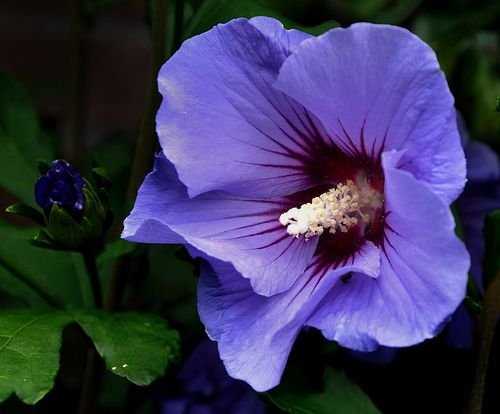

Description
Blushing Bride Hibiscus, also known as Hibiscus rosa-sinensis ‘Blushing Bride’, is a tropical flowering plant that belongs to the Malvaceae family. It is characterized by its stunning, large, white blooms with a hint of pink blush, resembling a blushing bride. The flowers usually measure around 6-8 inches in diameter and have a trumpet-like shape.
Growing Tips
Blushing Bride Hibiscus can be grown both indoors and outdoors, depending on the climate. Here are some tips to help you successfully grow and care for this beautiful plant:
- Light: Blushing Bride Hibiscus thrives in full sun to partial shade. Place it in an area that receives at least 6 hours of sunlight each day.
- Temperature: This hibiscus variety prefers warm temperatures between 65-80°F (18-27°C). Protect it from frost during colder months.
- Watering: Keep the soil consistently moist but not waterlogged. Water the plant deeply whenever the top inch of soil feels dry.
- Fertilizer: Feed Blushing Bride Hibiscus with a balanced, water-soluble fertilizer every 2-3 weeks during the growing season. Follow the package instructions for proper dosage.
- Pruning: Prune the plant in early spring to remove any dead or damaged branches. This will promote healthy growth and encourage more blooms.
Varieties
While Blushing Bride Hibiscus is a popular choice, there are other varieties of hibiscus you may want to explore. Some of these include:
- Hibiscus syriacus (Rose of Sharon): Known for its large, showy flowers and long blooming period.
- Hibiscus moscheutos (Swamp Rose Mallow): Native to North America, it produces large, colorful flowers.
- Hibiscus acetosella (Cranberry Hibiscus): Known for its burgundy foliage and edible flowers.
- Hibiscus sabdariffa (Roselle): Grown for its edible calyxes, which are used to make herbal tea.
Whether you choose Blushing Bride Hibiscus or one of the other varieties, growing hibiscus can add beauty and tropical vibes to your garden or indoor space.
Golden Sunshine Hibiscus
The Golden Sunshine Hibiscus is a beautiful variety of Syrian Hibiscus that is known for its vibrant yellow flowers that resemble a ray of sunshine. This variety is a favorite among gardeners for its striking color and its ability to attract pollinators.
Growing Tips
- Plant the Golden Sunshine Hibiscus in well-draining soil that is rich in organic matter.
- Ensure that the plant receives full sun for at least 6 hours a day.
- Water the plant regularly, keeping the soil evenly moist but not waterlogged.
- Apply a balanced fertilizer every 4-6 weeks during the growing season to promote healthy growth and blooming.
- Prune the plant in early spring to remove any dead or damaged branches.
Varieties
There are several different varieties of Golden Sunshine Hibiscus to explore. Some popular varieties include:
- Golden Tears: This variety produces large, golden-yellow flowers and has a compact growth habit.
- Golden Glow: This variety has double flowers with an orange-yellow color and a pleasant fragrance.
- Golden Princess: This variety features large, ruffled flowers in a deep golden-yellow color.
Uses
The Golden Sunshine Hibiscus is a versatile plant that can be used in various ways:
- As a focal point in the garden, thanks to its vibrant color.
- In containers on patios or balconies, adding a touch of sunshine to small spaces.
- In flower arrangements, the flowers of the Golden Sunshine Hibiscus make a stunning addition to bouquets.
Conclusion
The Golden Sunshine Hibiscus is a stunning variety of Syrian Hibiscus that brightens up any garden with its yellow flowers. By following the growing tips and exploring different varieties, you can enjoy the beauty of this hibiscus in your own garden.
Questions and Answers:
What are some tips for growing Syrian hibiscus?
Some tips for growing Syrian hibiscus include planting it in well-draining soil, providing it with full sun, and watering it regularly. It is also important to fertilize the plant during the growing season and prune it to maintain its shape.
Can Syrian hibiscus tolerate cold temperatures?
No, Syrian hibiscus is not cold hardy and cannot tolerate freezing temperatures. It is best suited for warm climates where the temperature does not drop below 50 degrees Fahrenheit.
What are some popular varieties of Syrian hibiscus?
Some popular varieties of Syrian hibiscus include ‘Lady Baltimore’ with its large pink flowers, ‘White Wings’ with white flowers, and ‘Copper Queen’ with deep red blooms. Other varieties include ‘Lilac Frost,’ ‘Golden Dream,’ and ‘Apricot Delight.’
How often should I water Syrian hibiscus?
Syrian hibiscus should be watered regularly, especially during hot and dry periods. The frequency of watering will depend on the temperature and moisture levels in your area, but generally, you should aim to keep the soil evenly moist but not waterlogged.
Do Syrian hibiscus require a lot of sunlight?
Yes, Syrian hibiscus requires full sun to thrive and produce abundant blooms. It should be planted in a location that receives at least 6 hours of direct sunlight each day. Lack of sunlight can result in poor growth and fewer flowers.
How can I propagate Syrian hibiscus?
Syrian hibiscus can be propagated through stem cuttings. Take a 4-6 inch cutting from a healthy, mature plant and remove the lower leaves. Dip the cut end in rooting hormone and plant it in a well-draining potting mix. Keep the cutting in a warm and humid environment and water it regularly. It should develop roots in a few weeks.







